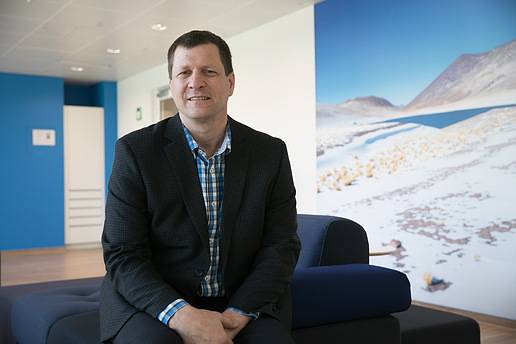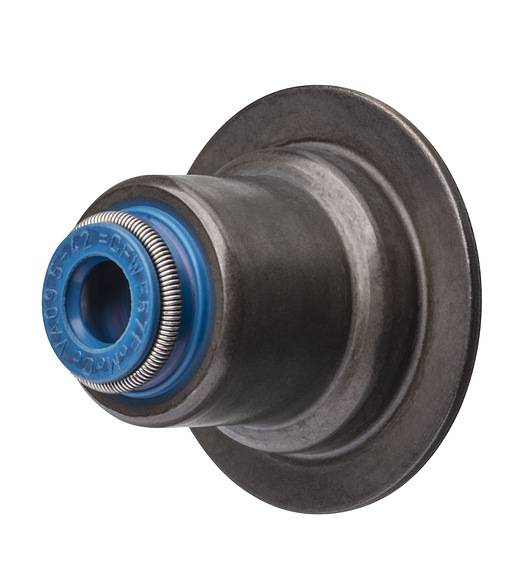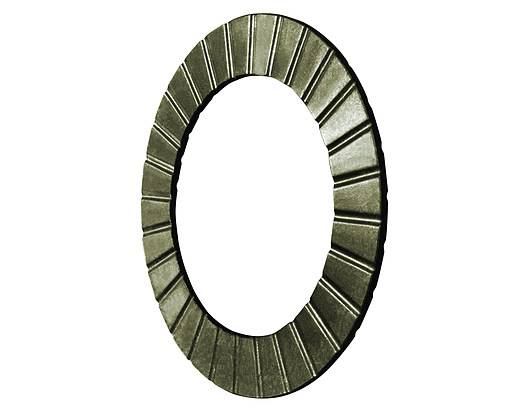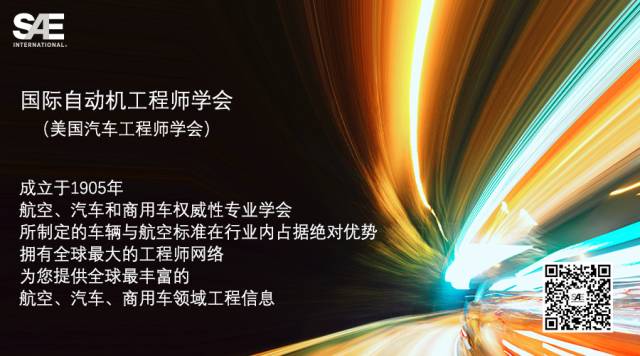 Joel Johnson目前担任Freudenberg-NOK密封技术公司运输机械工程部的全球副总裁。
Joel Johnson目前担任Freudenberg-NOK密封技术公司运输机械工程部的全球副总裁。 过去10年中,发动机和传动系密封系统的能效提升了近50%。Johnson相信,通过应用和改良已有的新技术,在现有基础上再提升50%的能效也不无可能。
过去10年中,发动机和传动系密封系统的能效提升了近50%。Johnson相信,通过应用和改良已有的新技术,在现有基础上再提升50%的能效也不无可能。 图为止推垫圈。
图为止推垫圈。
如今,人们对于非公路用车和卡车的需求已变得愈发复杂。车辆必须更环保,能在更苛刻的工况下运行,行驶时长更久,还需运用最新的材料和科技技术,达到最佳性能,满足市场需求。而为了更好地满足未来全球范围的减排需求,就需要将已有的技术更广泛地投入应用,同时也需要性价比更高的新技术研发有所突破。作为密封装置、蓄能器和高性能材料的领先制造商,Freudenberg密封技术公司正积极致力于现有和待开发的各类动力系统,以满足世界各地不同的客户需求。
在讨论排放的测量时,议题的中心往往是法规要求,但总的来说,提高能效是节能减排最直接有效的途经。像发动机小型化、燃油直喷、废气再循环、减小摩擦以及减少使用不必要的催化剂等手段,都会影响发动机的能效,从而改变排放量。
系统最优化
要实现系统最优化并延长车辆寿命,先进的密封技术起着至关重要的作用。举例来说,密封技术决定着自动变速传动系统中近1/4的机械能损耗,所以,自动变速系统制造商十分渴望能进一步减少系统摩擦,从而将机械能损耗降到最低。而如今,全新的密封材料和密封设计将会有效减轻系统重量,减少摩擦,并降低油耗。
而在发动机方面,我们面临的挑战很多,包括要能匹配更加轻量化的发动机,并且能适应发动机更极端的高温/低温工况要求。而随着更先进的燃料和润滑油的应用,以及更加苛刻的驾驶工况出现,由此带来的一系列挑战也是我们必须面对的。为此,Freudenberg公司和客户之间密切合作,制定出应对这些挑战的各种方案,同时针对各种不同的动力系统,进行节能减排性能的优化。目前,公司已经研发出了新的密封技术,能够承受超过18,000小时的高负荷运转,并计划将这一数字翻倍。
而在密封系统优化的研发中,明确各种应用需求至关重要。有时客户往往会提出一些极具挑战性的要求,时常同污染排放或温度设定有关。而密封技术是摩擦学的一部分,所以如果没有把所有性能参数都仔细分析过,就无法实现系统的正常运转。在很多时候需要同时采用多种密封技术,但是只有全面分析过速度、温度、用途、环境、压力、尺寸(也被称为S.T.A.M.P.S.)等各项参数,才能确定最优的解决方案。
Freudenberg公司同时也在不遗余力地进行低排放密封技术(LESS)产品的研发。LESS部件在制造和实测时,都会首先考虑S.T.A.M.P.S.参数,以实现各种运输机械和卡车的节能减排。这些产品包括:用于柴油发动机的改进款阀杆(有助于机油计量和漏气控制)、新一代曲轴密封技术(摩擦降幅可达90%)、更先进的密封材料及加工技术(以便改善机油的流动和压力,实现功率损失的最小化,提高传动系能效)、改良的密封垫(能适应承受度更强的塑料罩)、兼容排气系统和尿素添加剂的密封垫,以及耐高温的车用尿素(AdBlue)接触材料等。
车辆电气化和其他全球主要趋势
除了动力系统优化之外,其他一些全球主流趋势也都着眼于未来的发动机减排战略。总体而言,所有欧洲和美国的新出厂设备,都严格遵循StageIV(四阶段)排放标准。所以当务之急是,需要了解其他国家或地区会以何种速度跟上这一减排步伐?比如,对于亟待解决空气污染问题的中国而言,其排放标准很可能会逐步向StageIV靠拢。然而,像印度或伊朗这些国家的情况就很难预测了。为此,全球的车辆制造商都必须尽可能地掌握尖端技术,以符合更严苛的法规和标准要求,同时,这也是为了更好地控制“总体拥有成本”(即TCO),延长现有设备的使用寿命。
车辆电气化也是一种主流趋势,但具体发展因市场而异。对于物料搬运设备而言,这一技术就被用在了工业用卡车上。卡车在封闭的环境里作业,并且需要额外配重以防止其翻倒。卡车的电池就充当了配重的角色,而一些客户也正想方设法用燃料电池组件取代原来的电池,这样就不再需要充电站了。这也被视为是节能减排的终极解决方案。不过,不同市场对设备电气化的需求也不尽相同。例如,农业用机械往往需要以一个恒定的速度作业相当长的时间,并且周围鲜有充电和加氢基础设施。在这一情况下,使用高效的柴油发动机就是最佳方案了,因为只要适时加油,设备就可以进行全天候的作业。
而对于城市的小型建筑工程机械而言,柴油混合动力车技术然效果更佳。柴油发动机以一个恒定的速度旋转,类似于一台发电机,可以大大降低噪音,而设备作业则完全依靠电动系统。但是,在某些情况下——比如对于挖掘机而言,用电动系统替代液压系统并不可行,而液压辅助储能系统则更管用。这样,液压系统产生的压力就能储存在蓄能器中,而不会再释放回液压系统。而在下一步作业启动时,就可以充分使用这部分能量,而不必耗费新的能源。而如果多项低负荷作业都能使用蓄能器中储备的能量,那么整体的能效平衡便能大大改善。
过去10年中,发动机和传输密封系统的能效提升了近50%。而通过应用和改良已有的新技术,在现有基础上再提升50%的能效也不无可能。目前,汽车行业正在使用已有技术对设计进行优化,客户将能够以一种更加经济的方式步入节能减排的新纪元。
本文作者系Freudenberg-NOK密封技术公司运输机械工程部全球副总裁Joel Johnson,属于《卡车与非公路设备工程》“高管视角(Executive Viewpoints)”年度系列报道的一部分。
Demands on off-highway vehicles and trucks today are exceedingly complex. Equipment must be more environmentally friendly, work in a more aggressive environment, run longer hours and rely upon the latest material and product technology to meet market demands for peak performance. To satisfy future global emissions-reduction demands, a wider application of existing technologies and the development of innovative yet cost-effective technologies is required. As a leading manufacturer of seals, accumulators and high-performance materials, Freudenberg Sealing Technologies is dedicated to addressing the existing and future system requirements of customers throughout the world.
Discussions regarding regulations often center around measuring emissions but, in general, improving efficiency is a direct input to improving emissions. Actions such as downsizing, direct injection, exhaust gas recirculation, friction reduction and selective catalytic reduction all affect engine efficiency and thus emissions.
Systems optimization
Advanced sealing solutions play a critical role in systems optimization and extending the overall life of the machine. For example, seals are responsible for nearly one-quarter of all lost mechanical energy in today’s automatic transmissions, so transmission manufacturers are keen to lower system friction to minimize this loss. New seal designs and materials available today can help lower system weight, reduce friction and lower fuel consumption.
In engines, we are challenged to support lightweight designs, accommodate extended temperature ranges and address challenges posed by advanced fuels, lubricants and aggressive media. Freudenberg works in close cooperation with customers to develop solutions that resolve these challenges, while also optimizing the efficiency and emissions performance of various powertrain systems. The company has developed seals that withstand more than 18,000 hours of hard operation with plans to double this.
In developing optimal sealing systems, it is essential to identify application conditions. In some cases, our customers have extreme requirements, perhaps relating to contaminant exclusion or temperature specifications. Seals are part of a tribological system and can’t function properly when all performance parameters are not carefully analyzed. In many cases, multiple sealing solutions can be considered, but the optimal solution becomes evident only through extensive analysis of factors like speed, temperature, application, media, pressure and size (S.T.A.M.P.S.)
Our company’s efforts have coalesced in the development of its Low Emission Sealing Solutions (LESS) portfolio of products. LESS components have been engineered and field-tested to address S.T.A.M.P.S. parameters that influence energy consumption, efficiency and emission challenges in mobile machinery and trucks. These products incorporate: valve stem modifications for diesel engines that facilitate oil metering and blow-by control; next generation crankshaft sealing technology that reduce friction up to 90%; material and process technologies that improve transmission efficiency through seals that use oil flow and oil pressure to minimize power loss; improved gaskets that accommodate the increased tolerance range of plastic covers; gaskets compatible with exhaust gas and urea additives; and AdBlue-resistant materials for high temperatures.
Electrification and other global trends
In addition to powertrain system optimization, other global trends also are driving future engine emission strategies. For the most part, all new equipment in Europe and in the United States conforms to Stage IV emission standards. A pressing question is where and to what degree will other regions follow suit? In China, for example, where air pollution is a major issue, we will likely see emission standards that converge with Stage IV limits. But what about in other markets like India and Iran? Global manufacturers must be able to incorporate new technologies that help meet stricter limits, while balancing a “total cost of ownership” approach that extends the life of existing equipment.
There’s also a trend toward electrification, but it varies by market. In material handling equipment, electrification certainly lends itself to industrial trucks. They are often operated in enclosed spaces and need additional weight so they don’t tip over. The battery supplies the counter weight and some customers are working to replace the battery with a fuel-cell assembly to eliminate the recharging station. This is the ultimate in emissions reduction. The view of the situation is different for each market though. Agricultural machines are often operated over long periods at a constant speed, far from any infrastructure. In this application, an efficient diesel engine is generally seen as the best choice because it can provide more of a 24/7 type performance only stopping for refueling.
For smaller construction machines used in an urban environment, a diesel-electric hybrid powertrain definitely makes sense. The diesel engine would run solely as a generator at a constant rotational speed, which reduces the noise level considerably, but the work is initiated via an electrical system. In some applications, such as a classic excavator, substitution of the hydraulic system with an electrical system is not practical, so hydraulic assist storage systems may make more sense. In these cases, the pressure generated by the hydraulic system is stored in an accumulator rather than being released back into the oil reservoir. This energy is then used to initiate the next machine movement rather than starting from scratch. If the phases with lower loads use the energy stored in the accumulator, the overall energy balance is improved.
During the past 10 years, the efficiency of engine and transmission sealing packages has been improved by nearly 50%. By applying and refining technologies available today, an absolute improvement of efficiency of the same magnitude can be achieved. By optimizing current designs with existing technology, customers are able to cost-effectively move the needle in emissions reduction.
Joel Johnson, Global Vice President, Mobile Machinery at Freudenberg-NOK Sealing Technologies, wrote this article for Truck & Off-Highway Engineering as part of our annual Executive Viewpoints series.
Author: Joel Johnson
Source: SAE Truck & Off-highway Engineering Magazine
等级
打分
- 2分
- 4分
- 6分
- 8分
- 10分
平均分
- 作者:Joel Johnson
- 行业:商用车
- 主题:动力与推进力
